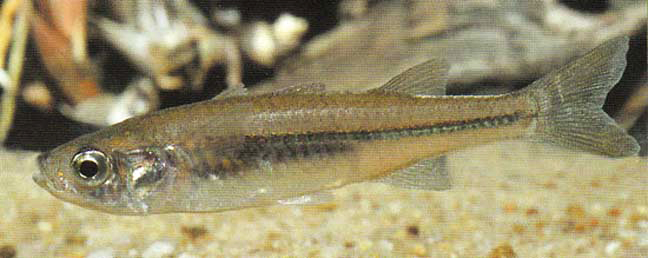Deep Hardyhead, Craterocephalus cuneiceps Whitley 1944

Deep Hardyhead, Craterocephalus cuneiceps. Source: Mark Allen. License: All rights reserved
Deep Hardyhead, Craterocephalus cuneiceps Whitley 1944
More Info
|
Distribution |
Known only from coastal rivers of the Carnarvon Basin, from Murchison River (27º38´S) to De Grey River on the NW coast of Western Australia. Found in the Greenough, Hutt, Murchison, Wooramel, Gascoyne and DeGrey rivers, but absent from numerous rivers within its range. Inhabiting slow-flowing, tropical freshwater streams and isolated pools in river beds in clear or turbid water. The species occurs spornal finadically within its geographical range. |
|
Features |
Dorsal fin IV-VI (unbranched rays) + I, 5-8; Anal fin I, 6-8; Pectoral fin 12-14. Body compressed somewhat elongate and deep; greatest body depth 3.7-4.8 in SL; head flattened above, tapering down towards ventral profile; snout acutely pointed; mouth oblique, extensile, apparently toothless; lower jaw longer than upper; jaw not reaching below eye. Scales large, entire, cycloid; vertical scale rows 30-33; horizontal scale rows 8-11; head with scales except before the eyes. No produced fin-spines; origin of first dorsal slightly nearer snout than root of caudal; anal base longer than that of dorsal, more than half its distance from caudal; origin of anal fin in front of level of second dorsal origin; third pectoral ray longest; pectorals reaching above ventral base; ventral fin origin about opposite first dorsal origin; caudal fin moderately forked. |
|
Size |
To 8.5 cm SL, commonly 5-6cm. |
|
Colour |
Dusky greyish-green overall, whitish ventrally with a silver mid-lateral stripe. |
|
Feeding |
Essentially a detritivore, but also feeding on aquatic invertebrates such as ostracods and insect larvae. The length of the intestine may be indicative of the inclusion of some aquatic plant material in the diet. |
|
Biology |
Spawning occurs throughout the year; very fecund with females producing numerous batches of eggs throughout the breeding season. Spawning begins when males are 30mm TL and females 40 mm. Spawn in pairs depositing demersal eggs amongst aquatic vegetation. Eggs spherical with adhesive filaments. |
|
Conservation |
|
|
Remarks |
The Deep Hardyhead is an extremely hardy species with a high salinity tolerance. A specialised diet, small size and young age at maturity, coupled with serial spawning and high fecundity, allows the numerical dominance of this species in competitive and unpredictable desert environments. |
|
Similar Species |
Similar in appearance to C. eyresii but differs from this species in lacking teeth, being slightly less deep-bodied and in having fewer horizontal scale rows. |
|
Etymology |
Generic name Craterocephalus comes from the Greek meaning bowl or basin and head, possibly in reference to the strong head of species in this genus; cuneiceps is from the Latin meaning head and wedge. |
|
Species Citation |
Craterocephalus cuneiceps Whitley, 1944, Aust. Zool. 10(3): 266. Type locality: Belele Station, via Meekatharra, WA. |
|
Author |
Vanessa J. Thompson |
Deep Hardyhead, Craterocephalus cuneiceps Whitley 1944
References
Allen, G.R. (1982). Inland Fishes of Western Australia. Perth : Western Australian Museum 86 pp.
Allen, G.R. (1989). Freshwater Fishes of Australia. Neptune, New Jersey : T.F.H. Publications pp. 1–240
Allen, G.R., Midgley, S.H. & Allen, M. 2002. Field guide to the freshwater fishes of Australia. Perth : Western Australian Museum 394 pp.
Allen M.G., Morgan D.L., Gill H.S. (2005) Distribution, zoogeography and biology of the Murchison River hardyhead (Craterocephalus cuneiceps Whitley, 1944), an atherinid endemic to the Indian Ocean (Pilbara) Drainage Division of Western Australia. Ecology of Freshwater Fish 14: 209–224.
Crowley, L.E.L.M & Ivantsoff, W. 1988. A new species of Australian Craterocephalus (Pisces: Atherinidae) and redescription of four other species. Rec. West. Aust. Mus. 14: 151–169.
Crowley, L.E.L.M. & Ivantsoff, W. (1992). Redefinition of the freshwater fish genus Craterocephalus (Teleostei: Atherinidae) of Australia and New Guinea with an analysis of three species. Ichthyol. Explor. Freshw. 3(3): 273–287.
Merrick, J.R. & Schmida, G.E. (1984). Australian Freshwater Fishes Biology and Management. Sydney : J.R. Merrick 409 pp.
Whitley, G.P. (1944). New sharks and fishes from Western Australia. Aust. Zool. 10(3): 252–273 figs 1–6

